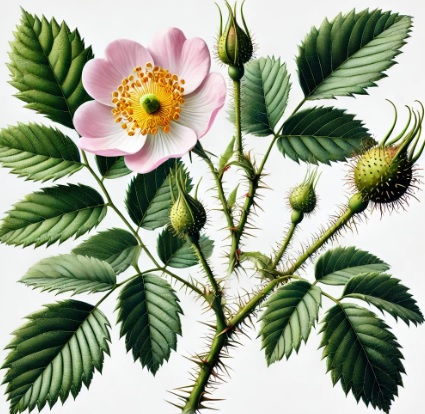Rosa roxburghii, commonly known as Roxburgh's rose, is a species of rose native to the mountainous regions of China, particularly in areas such as the Sichuan province. This rose is noted for its distinctive, spiny fruit and attractive, fragrant flowers. The plant is valued for both its ornamental qualities and its potential health benefits.
Botanical Classification:
Kingdom: Plantae
Order: Rosales
Family: Rosaceae
Genus: Rosa
Species: Rosa roxburghii
Plant Characteristics:
Rosa roxburghii is characterized by:
Bright, showy flowers that are typically pink or white, with a pleasant fragrance
Unique, spiny fruits (hips) that are round and covered with fine, needle-like thorns, which give the plant its distinctive appearance
Dark green, glossy leaves that are ovate and serrated, providing a lush backdrop for the flowers and fruits
A shrub-like growth habit, typically reaching heights of 1 to 2 meters and spreading outwards, with a preference for well-drained soil and full sunlight
Chemical Composition and Structure:
The chemical composition of Rosa roxburghii includes:
Essential oils with aromatic compounds such as citronellol and geraniol, contributing to its fragrance
Flavonoids and polyphenols in the petals and fruits, which offer antioxidant and anti-inflammatory properties
Vitamin C, particularly concentrated in the fruit (hips), providing significant antioxidant benefits and supporting immune health
Uses and Benefits:
Aesthetic: Valued for its vibrant flowers and ornamental spiny fruit, making it a striking addition to gardens and landscapes.
Cosmetic: Extracts from the plant, particularly from the fruit, are used in skincare products for their antioxidant and anti-inflammatory properties.
Medicinal: Traditionally used in Chinese medicine for its potential health benefits, including boosting immune function and improving skin health due to its high vitamin C content.
Culinary: The fruit (hips) can be used to make jams, jellies, and infusions, adding a tangy flavor and providing a source of vitamin C.
Applications:
Gardening: Used as an ornamental shrub in gardens and landscapes for its unique appearance and vibrant flowers.
Cosmetics: Extracts incorporated into skincare products such as creams and serums for their antioxidant and anti-inflammatory effects.
Medicinal: Utilized in traditional herbal remedies and supplements for its potential health benefits, including immune support and skin health.
Culinary: Fresh or dried hips used in making jams, jellies, teas, and other culinary products.
Environmental and Safety Considerations:
Environmental Impact: Non-invasive and well-suited to its native mountainous regions; contributes to garden biodiversity and supports local pollinators.
Safety: Generally safe to handle and use; however, individuals with allergies or sensitivities should be cautious. It is advisable to consult with a healthcare provider before using Rosa roxburghii for medicinal purposes.
INCI
Antioxidant agent. Ingredient that counteracts oxidative stress and prevents cell damage. Free radicals, pathological inflammatory processes, reactive nitrogen species and reactive oxygen species are responsible for the ageing process and many diseases caused by oxidation.
Surfactant - Foam booster. It has the effect of introducing gas bubbles into the water and affects the cleaning process by helping to spread the cleanser. Since sebum has an inhibiting effect on the bubble, more foam is produced in the second shampoo.
Hair conditioning agent. A significant number of ingredients with specific and targeted purposes may co-exist in hair shampoo formulations: cleansers, conditioners, thickeners, matting agents, sequestering agents, fragrances, preservatives, special additives. However, the indispensable ingredients are the cleansers and conditioners as they are necessary and sufficient for hair cleansing and manageability. The others act as commercial and non-essential auxiliaries such as: appearance, fragrance, colouring, etc. Hair conditioning agents have the task of increasing shine, manageability and volume, and reducing static electricity, especially after treatments such as colouring, ironing, waving, drying and brushing. They are, in practice, dispersants that may contain cationic surfactants, thickeners, emollients, polymers. The typology of hair conditioning agents includes: intensive conditioners, instant conditioners, thickening conditioners, drying conditioners. They can perform their task generally accompanied by other different ingredients.
Nail Conditioning agent. It is an agent that creates protection against harmful or chemical substances by strengthening the nail structure against external elements and can repair any chipping, cracking or brittle nails. It helps keep the nail's outer layer and keratin protein in good condition. It can also prevent cracking and peeling of the nail.
Skin conditioning agent. It is the mainstay of topical skin treatment as it has the function of restoring, increasing or improving skin tolerance to external factors, including melanocyte tolerance. The most important function of the conditioning agent is to prevent skin dehydration, but the subject is rather complex and involves emollients and humectants that can be added in the formulation.
Synonyms:
CAS: 223748-27-4
![]() Rosa Roxburghii
Rosa Roxburghii 

